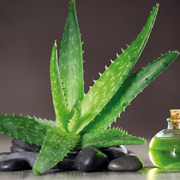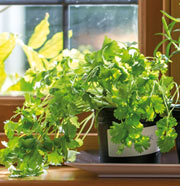If you’ve been thinking of giving herbal remedies a shot, here’s a little guide to get you started. You can grow these medicinal herbs at home and reach out to them whenever you need a dose of gentle plant medicine.
Aloe vera
One of the first medicinal plants that most of us start with is aloe vera. The fleshy leaves are packed with a gel that can be used externally to treat several skin ailments. For any kind of burn—from overexposure to sun to minor cooking burns—simply break off a leaf, run a knife up the middle of the leaf and open it out. Smear the gel on the affected area and leave it to dry. The opened out leaf can be wrapped in cling film and kept in the fridge, which makes it even more cooling.
How to grow: Aloe vera can be grown in a container. You can get a plant from the nursery or propagate it by rooting an offshoot that forms near the base of the plant. This medicinal plant likes a lot of sunshine but can also thrive in partial shade. Make sure the soil is fertile and well-drained.
Basil
There are two types of Basil—Sweet Basil and Holy Basil—and both do wonders for our health. But while most of us in India do have a tulsi or Holy Basil plant in our homes, not many of us grow or use Sweet Basil. You can use the leaves of Basil plant in cooking, especially in Italian dishes, and can flavour vinegars and oils with it. Basil leaves can also be made into infusions that help with digestion and reduce fevers. If you pop a handful of leaves in the bath, it acts as a stimulant.
How to grow: Basil needs well-drained, moist, nutrient-rich soil. You can grow this herb from seed by tucking the seeds 1.4 inch deep in the soil mix. Make sure you keep a gap of 10 – 12 inches between the seeds and keep the container in a place that gets a good amount of sun.
Calendula
You can identify this plant by its bright yellow flowers that bloom in the beginning of spring. This is a versatile herb that can be used for cooking and cure. The fresh petals of the flower can be sprinkled over stir-fries, while the dried petals can be used to colour cooked rice.
The petals can also be infused with oil and used to prepare salves and ointments at home. Creams made with calendula-infused oil help to heal burns, cuts and bruises. Calendula ointment is also good for diaper rashes. A salve made with calendula can bring relief to sore muscles, while a lip balm that contains calendula-infused oil can heal dry, chapped lips. You can also make calendula hydrosol or tincture with the petals that can further be used in a misting spray to bring relief to bee stings and bug bites, and as a facial toner.
“To make a tincture, take a glass jar and fill with Calendula flowerheads. Pour alcohol [standard strength alcohol is easiest to get for most people] on top and make sure the flowerheads are all covered. Leave the flowerheads in the alcohol for 2 – 3 weeks, stirring every other day. Strain the flowerheads off and keep the remaining tincture in a dark glass bottle,” shares herbalist and educator Pamela Spence.
How to grow: Calendula can be directly sown into the ground in the fall or can be planted indoors. Very easy to maintain, this plant needs a lot of sunshine and fertile, well-drained soil. Calendula doesn’t grow well in extreme weathers such as very hot summers and freezing winters.
Coriander
Also known as cilantro or dhania in India, this is a dynamic herb packed with vitamins C and K, and small amounts of carotene, niacin, thiamine, potassium, phosphorous and calcium. Coriander is known to lower bad cholesterol and increase good cholesterol, improve bowel movements and promote liver function, lower blood sugar levels in diabetics and improve the secretion of insulin. This herb works well against diseases like arthritis.
How to grow: You can grow coriander in a container or in the garden directly. Crush the seeds and tuck them into the soil in short, straight rows. Coriander grows well when it is sown in fertile soil and receives a lot of sunshine.
Celery
Here is a herb that we best associate with salads and soups, but it does more than just add flavour to food. Celery is known to reduce high blood pressure, lower high cholesterol, prevent ulcers and protect the liver. It also reduces bloating, improves digestion, and prevents urinary tract infections.
How to grow: This herb loves a lot of sun and water. Plant in an 8-inch deep container, and make sure that the potting mix is rich and fertile.
Mint
Known as pudina in India, this is an easy-to-grow herb that is soothing to the stomach. A herbal tea made with this herb can cure stomach ache and reduce irritated bowel syndrome. Crushed mint leaves can combat bad breath and mint leaves added to cool beverages help cool the body down. Mint is also known as a good blood-cleanser.
“Fresh mint leaves are best used as an infusion. Simply add to boiled water, cover and allow to steep for 5 – 10 minutes. One can drink it either hot or cold,” advises Spence, explaining that this infusion is an excellent remedy for nausea and indigestion.
How to grow: If you know anyone who grows mint, ask them to give you a few plants. These can be pulled out from pot, and can be planted 12 inches apart and two inch deep. Water the plants well. Once these take root, they grow prolifically. They grow well in shade and sun, but seem to enjoy the latter more.
Lemongrass
A herbal tea made with lemongrass is known to relieve headaches, stomach aches, menstrual cramps and muscle pain. Essential oil made from this plant is known to ward off mosquitoes. Lemongrass is also a culinary herb and used prolifically in Asian cuisine.
How to grow: This herb can grow from two to four feet tall and can be grown in containers. It grows well in warm weather and is propagated from a section of the roots. This easy-to-grow herb just needs sunshine, fertile soil and lots of water.
Thyme
Add fresh thyme to salads, stews, soups and sauces, infuse your cooking oil with it to add another layer of flavour to your food, and use home-dried thyme to potpourri to repel insects. As a medicine, a thyme infusion is known to settle the stomach; the herb can also be added to bath water to soothe raw or rough skin.
How to grow: Thyme needs hot and dry weather to grow well. You can grow it from seed in a raised bed or in a pot. Sow the seeds in fall so that they sprout in summer. Water this herb every other day when the weather is not too hot and every day, when the sun is scorching.
Armed with containers and pots, a good soil mix and this know-how, you can start growing herbs at home, and use them to enhance your health.
 Spot an error in this article? A typo maybe? Or an incorrect source? Let us know!
Spot an error in this article? A typo maybe? Or an incorrect source? Let us know!








